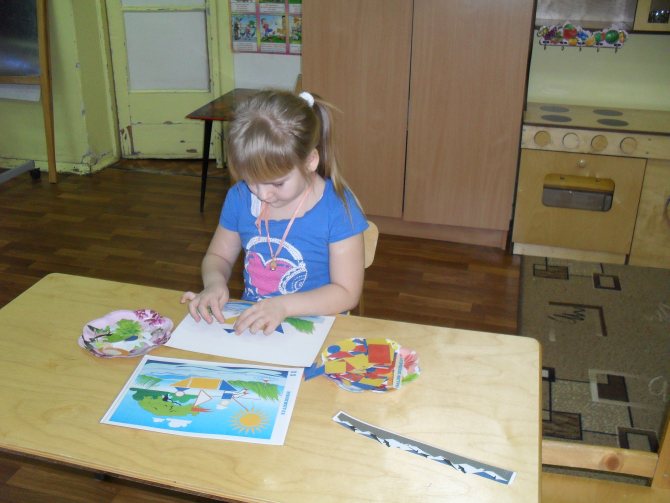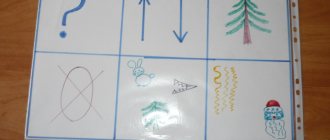Visual modeling technology in the correction of general speech underdevelopment of preschool children
Bibliographic description:
Pilipenko, T.V. Technology of visual modeling in the correction of general speech underdevelopment of preschool children / T.V. Pilipenko. — Text: direct // Education and upbringing. — 2022. — No. 1 (16). — P. 22-25. — URL: https://moluch.ru/th/4/archive/81/3074/ (access date: 01/19/2022).
Preschool education is the first stage in the education system, therefore the main task of teachers working with children with general speech underdevelopment is to create interest in the learning process and its motivation, development and correction of speech. Today it is absolutely possible to identify the emerging contradictions between the normative content of education common to all pupils and the individual capabilities of children. Children of senior preschool age with various speech disorders experience significant difficulties in mastering both the kindergarten curriculum and the curriculum in a comprehensive school. Learning difficulties are especially typical for children with general speech underdevelopment.
Working with children with various speech pathologies and facing problems in their learning, the speech therapist has to look for auxiliary means that facilitate, systematize and guide the process of children’s learning new material. One of these tools is visual modeling. What is visual modeling?
Visual modeling is the reproduction of the essential properties of the object being studied, the creation of its substitute and work with it.
The visual modeling method helps the child visually imagine abstract concepts (sound, word, sentence, text) and learn to work with them. This is especially important for preschoolers, since their mental problems are solved with the predominant role of external means; visual material is absorbed better than verbal material.
The preschooler is deprived of the opportunity to write down, make a table, or mark anything. In kindergarten classes, only one type of memory is mainly involved - verbal. Supporting schemes are an attempt to use visual, motor, and associative memory to solve cognitive problems.
Scientific research and practice confirm that visual models are the form of highlighting and designating relationships that is accessible to preschool children (Leon Lorenzo S., Khalizeva L. M., etc.). Scientists also note that the use of substitutes and visual models develops the mental abilities of preschoolers.
Consequently, using the visual modeling method in working with preschoolers allows us to solve the following problems:
‒ firstly, a preschool child is very flexible and easy to teach, but children with general speech underdevelopment are characterized by rapid fatigue and loss of interest in activities. Using visual modeling creates interest and helps solve this problem;
‒ secondly, the use of symbolic analogy facilitates and speeds up the process of memorizing and assimilating material, and forms techniques for working with memory. After all, one of the rules for strengthening memory says: “When you teach, write down, draw diagrams, diagrams, draw graphs”;
‒ thirdly, using a graphic analogy, we teach children to see the main thing and systematize the acquired knowledge.
Modeling consists of the following stages:
- assimilation and analysis of sensory material;
‒ translating it into sign-symbolic language;
- work with the model.
The formation of visual modeling skills occurs in a certain sequence with a constant increase in the proportion of independent participation of preschoolers. When developing visual modeling skills, the following didactic tasks are solved:
‒ familiarity with the graphical method of presenting information;
- development of the ability to decipher the model;
‒ developing the skill of independent modeling.
In speech therapy work, modeling acts as a specific method of cognition, on the one hand, and, on the other, as a program for analyzing new phenomena.
When preparing children for learning to read and write, the visual modeling method allows you to solve the following problems:
‒ intonationally highlight the sound in a word
‒ name words with a given sound
- find the position of a sound in a word and correlate it with the diagram
- depict vowel and consonant sounds using visual symbols.
When working with children, Tkachenko T. A.’s manual “Sounds and Signs” is successfully used to develop skills in sound analysis and synthesis.
Symbols of vowel sounds are indicated by geometric shapes familiar to children, corresponding to the position of the lips when articulating vowel sounds. To indicate consonant sounds, a visual image of an object or object capable of producing the corresponding sound is used. Children gradually become familiar with visual symbols as they learn vowels and consonants.
With the help of visual symbolism, children learn to analyze and synthesize the sound composition of a word. Merging sounds with the help of symbols is a simulation of reading, and composing words is an analogue of writing. But both happen in a lightweight, entertaining, playful version. Visual symbols improve the perception of speech sounds, contribute to the normalization of sound pronunciation, provide stable skills in sound analysis and synthesis, increase readiness for reading and writing, and train the child’s memory and attention.
When teaching literacy, a wide variety of games are used: “Spread pictures in the house”, “Where is the sound?”, “Traffic light”, “Where did the butterfly fly?”, etc.
In these games, children learn to identify the first and last sounds in words and relate them to the diagram; determine and mark the position of a given sound in a word; divide words into syllables. Modeling allows children to figuratively imagine the structure of a word, using substitutes for the syllables of which it consists, learn to determine the number of syllables, and relate the word to the syllable pattern. Children are prepared to develop the skill of syllable reading.
To form the syllabic structure of a word , the following games and exercises using models are successfully used: “Drawing Words”, “Pyramid”, “Houses”, etc.
Also, the visual modeling method helps improve lexical and grammatical categories . To do this, the following games and exercises are carried out using diagrams and models: “Clearing of related words”, “Choose the right picture”, “What is the word?”, “What is the preposition?” etc. In these games, children develop word formation and inflection skills, preschoolers learn to select related words based on conventional notation; They clarify spatial relationships expressed by prepositions, learn to compose sentences with them, and correctly use prepositions in speech.
When teaching coherent speech, the visual modeling method is used to work on all types of coherent utterances:
- retelling;
- compiling stories based on a painting and a series of paintings;
- descriptive story;
- creative story;
Schemes for writing descriptive stories on topics:
"Wild Animals" "Toys"
At this stage, the visual modeling method contributes to:
‒ mastering the principle of substitution (the ability to designate characters and attributes of a work of art with substitutes), conveying an event with the help of substitutes;
‒ mastering the ability to identify fragments of a picture that are significant for the development of the plot, determine the relationship between them and combine them into one plot;
- developing the ability to create a special plan and develop it into a complete story with various details and events;
- learning to write descriptive stories.
Using the visual modeling method in correctional work allows children to learn:
- obtain information, conduct research, make comparisons, draw up a clear internal plan for mental actions and speech statements;
- formulate and express judgments, draw conclusions;
- has a positive effect on the development of non-speech processes: attention, memory, thinking.
Consequently, we can conclude that by analyzing new material and graphically designating it, the child (under the guidance of adults) learns independence, perseverance, and visual perception of the plan of his actions. His sense of interest and responsibility increases, he becomes satisfied with the results of his work, mental processes such as memory, attention, and thinking improve, which has a positive effect on the effectiveness of correctional work.
The use of visual modeling in the system of correctional work gives a positive result, which is confirmed by diagnostic data on the level of speech development of children.
Thus, from all of the above, we can conclude: the visual modeling method can and should be used in the system of both correctional work with children of preschool and primary school age, and in work with children of mass groups of kindergarten and primary school.
Literature:
- Vorobyova V.K. Methodology for the development of coherent speech in children with systemic speech underdevelopment. -M., 2005
- Glukhov V.P. Formation of coherent speech in preschool children with general speech underdevelopment. - M., 2004
- Davydova T. G. Vvoznaya V. M. The use of support schemes in working with children. // Directory of senior preschool teacher 2008 No. 1
- Kudrova T.I. Modeling in teaching literacy to preschoolers with speech underdevelopment. // Speech therapist in kindergarten 2007 No. 4 p.51 -54
- Overcoming general speech underdevelopment in preschool children. / Ed. T.V. Volosovets. - M., 2007
- Rastorgueva N. I. Using pictograms to develop word formation skills in children with general speech underdevelopment. // Speech therapist 2002 No. 2 p.50–53
- Smyshlyaeva T. N. Korchuganova E. Yu. Using the method of visual modeling in the correction of general speech underdevelopment of preschool children. // Speech therapist 2005 No. 1 p. 7–12
- Tkachenko T. A. If a preschooler speaks poorly - St. Petersburg, 1997
- Tkachenko T. A. In first grade without speech defects - St. Petersburg, 1999.
Key terms
(automatically generated)
: visual modeling, child, word, kindergarten, correctional work, general speech underdevelopment, given sound, sound analysis, skill formation, skill formation.
Consultation for educators “Modeling method in the educational process of preschool educational institutions”
MDOU kindergarten No. 47 “Veterok”
Consultation for educators
“Modeling method in the educational process of preschool educational institutions”

“Modeling method in the educational process of preschool educational institutions”
1.Modeling and its essence.
2. Requirements for models.
4. Methodological recommendations for introducing models into the educational process.
5.Use of the modeling method in various types of children's activities.
Modeling –
the process of creating models and their use in order to generate knowledge about the properties, structure, relationships, connections of objects. The peculiarity of modeling as a teaching method is that it makes visible the properties, connections, relationships of objects that are hidden from direct perception, which are essential for understanding facts, phenomena, in the formation of knowledge that is close in content to concepts.
The accessibility of the modeling method for preschoolers was shown by psychologists (A.V. Zaporozhets, L.A. Venger, N.N. Poddyakov, D.B. Elkonin). It is determined by the fact that modeling is based on the principle of substitution: a real object can be replaced in children’s activities by another object, image, sign. Models have been developed for the formation of natural history knowledge, speech development, sound analysis of words, construction, visual activities, etc. (N.I. Vetrova, L.E. Zhurova, N.M. Krylova, V.I. Loginova, L.A. Paramonova, T.D. Richterman, etc.).
Requirements for the model
In order for a model as a visual and practical means of cognition to fulfill its function, it must meet a number of requirements:
1. clearly reflect the basic properties and relationships that are the object of cognition, be similar in structure to the object being studied. 2. be easy to understand and accessible to create and act with; 3. clearly and clearly convey those properties and relationships that must be mastered with its help; 4. it should facilitate cognition (M.I. Kondakov, V.P. Mizintsev).
In didactics there are three types
models:
1. Subject model -
has the appearance of a physical structure of an object or objects that are naturally connected. In this case, the model is similar to the object, reproducing its main parts, design features, proportions and relationships of parts in space, and the interconnection of objects. What distinguishes such a model from a toy is the accuracy of its reproduction of essential connections and dependencies within the modeled object or between them, and the ability to detect these dependencies in activities with the model.
2. Subject-schematic model. —
Here, the essential components and connections between them identified in the object of cognition are indicated using substitute objects and graphic signs. The structure of such a model should be similar to the main components of the object being studied and to those connections and relationships that become the subject of cognition. The subject-schematic model should detect these connections and clearly present them in an isolated, generalized form.
3.Graphic models. —
Different types of relationships are conveyed in a generalized manner (graphs, formulas, diagrams). This type of model is used mainly in school.
Guidelines for introducing models
into the educational process
The methodology for introducing models into the cognition process must take into account a number of circumstances:
1.
The model, revealing the connections and relationships necessary for cognition, simplifies the object, representing only its individual aspects, individual connections. Consequently, the model cannot be the only method of cognition: it is used when it is necessary to reveal for children this or that essential content in an object. This means that the condition for introducing models into the process of cognition is the preliminary familiarization of children with the real objects, phenomena themselves, their external features, specifically represented connections and mediations in the surrounding reality.
2.
The introduction of a model requires a certain level of development of mental activity: the ability to analyze and abstract the features of objects and phenomena; imaginative thinking that allows you to replace objects; ability to establish connections. And although all these skills are formed in children in the process of using models in cognitive activity, introducing them, mastering the model itself and using it for further cognition requires a level of differentiated perception, imaginative thinking, coherent speech and a rich vocabulary that is already quite high for a preschooler.
3.
Using a model to understand the essential features of objects requires children to first master the model. At the same time, children master simple object models quite quickly. More complex connections require more complex subject-schematic models and special techniques. In this case, children are first involved in the process of creating a model, which is linked to the observation and analysis of the modeled phenomenon. This allows the child to identify the components of the object being analyzed and to master what will then be subject to analysis in their model. Thus, the development of the model itself is presented in the form of children’s participation in creating the model, participation in the process of replacing objects with schematic images. This preliminary mastery of the model is a condition for its use to reveal the connection reflected in it.
Using the “modeling” method in various types of children's activities
1. Modeling in the mathematical development of children.
a) Dienesh’s logical blocks are a set of three-dimensional geometric shapes that differ in shape, color, size, and thickness. b) Cuisinaire sticks - a set of counting sticks of different colors and different lengths. Sticks of the same length are painted the same color and represent the same number. The longer the stick, the greater the value of the number it expresses. c) The modeling method in mathematics is often found in the form of “chains of symbols”. For example, combinations of symbols are used when orienting on a sheet of paper. d) You can also refer to reference diagrams when using abbreviations to designate months of the year.



